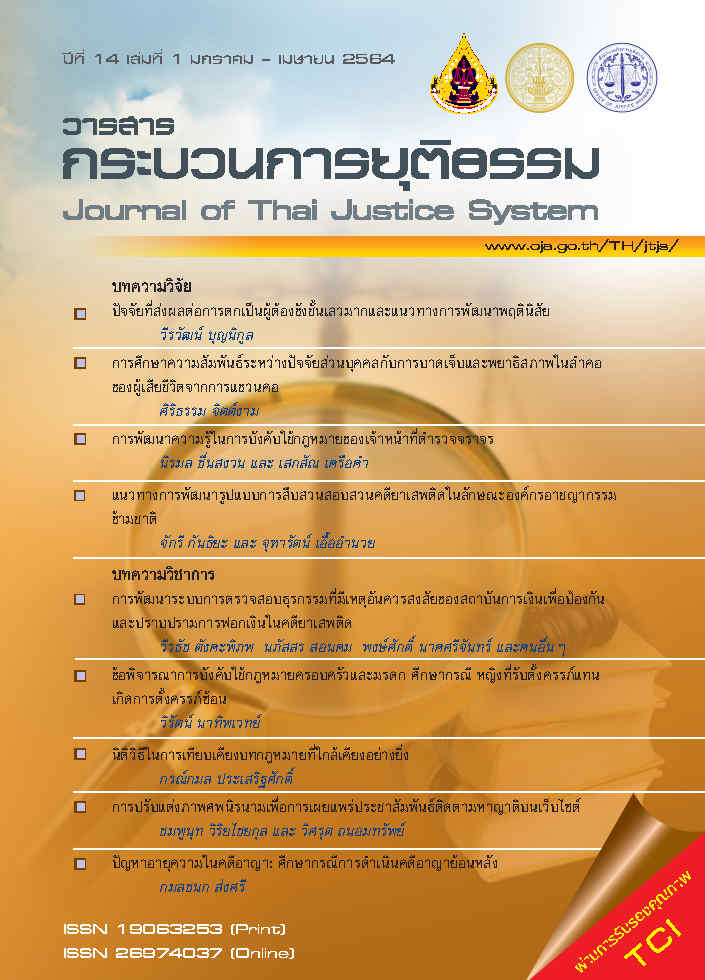ข้อพิจารณาการบังคับใช้กฎหมายครอบครัวและมรดก ศึกษากรณี หญิงที่รับตั้งครรภ์แทนเกิดภาวะการตั้งครรภ์ซ้อน
Main Article Content
บทคัดย่อ
บทความนี้มีวัตถุประสงค์เพื่อที่จะศึกษา การบังคับใช้กฎหมายครอบครัวและมรดกกับเด็กที่เกิดจากการตั้งครรภ์ซ้อนของแม่อุ้มบุญ การตั้งครรภ์ซ้อนเป็นกรณีที่หญิงที่รับตั้งครรภ์แทน (แม่อุ้มบุญ) ได้มีการตกไข่(เซลล์สืบพันธุ์เพศหญิง) ขึ้นภายหลังจากที่เสร็จสิ้นกระบวนการทางเทคโนโลยีช่วยการเจริญพันธุ์ทางการแพทย์ เมื่อไข่ได้รับการผสมกับอสุจิ (เซลล์สืบพันธุ์เพศชาย) ของสามีโดยชอบด้วยกฎหมายของหญิงที่รับตั้งครรภ์แทนทำให้เกิดการตั้งครรภ์ซ้อนขึ้นมาจากเด็กคนแรก เมื่อเด็กคลอดออกมา ทำให้เกิดการสำคัญผิดในข้อเท็จจริงว่าเด็กที่เกิดขึ้นมาภายหลังเป็นเด็กที่เกิดจากเทคโนโลยีช่วยการเจริญพันธุ์ทางการแพทย์ ทั้งที่จริงแล้วเด็กเกิดจากการปฏิสนธิตามธรรมชาติ จึงมีการนำพระราชบัญญัติคุ้มครองเด็กที่เกิดโดยอาศัยเทคโนโลยีช่วยการเจริญพันธุ์ทางการแพทย์ พ.ศ.2558 บังคับใช้กับเด็กที่เกิดจากการตั้งครรภ์ซ้อน ทำให้เด็กถูกแยกออกจากครอบครัวที่แท้จริงและไม่อยู่ในฐานะผู้ทรงสิทธิตามกฎหมายครอบครัวและมรดกที่จะได้รับสิทธิตามกฎหมายดังกล่าวโดยชอบด้วยกฎหมาย
Article Details
ต้นฉบับที่ได้รับการตีพิมพ์ในวารสาร เป็นลิขสิทธิ์ของวารสารกระบวนการยุติธรรม แต่ความคิดเห็นที่ปรากฏในเนื้อหาของบทความในวารสารกระบวนการยุติธรรม ถือเป็นความรับผิดชอบของผู้เขียนแต่เพียงผู้เดียว
เอกสารอ้างอิง
กีรติวรรณ กัลยาณมิตร. (2557). การกำหนดนโยบายคุ้มครองเด็กที่เกิดโดยอาศัยเทคโนโลยีช่วยการเจริญพันธุ์ทางการแพทย์ในประเทศไทย. วารสารรัชต์ภาคย์, 11(24), 189-198.
กันย์กัญญา ใจการวงค์สกุล. (2560). กฎหมายแพ่งและหลักทั่วไป. กรุงเทพฯ: วิญญูชน.
คณะกรรมการจัดทำพจนานุกรมศัพท์กฎหมายไทย. (2556). พจนานุกรมศัพท์กฎหมายไทย (พิมพ์ครั้งที่ 4). กรุงเทพฯ: ราชบัณฑิตยสถาน.
บวรศักดิ์ อุวรรณโณ. (2537). ประมวลกฎหมายแพ่งและพาณิชย์ บรรพ 6 ว่าด้วยมรดก. กรุงเทพฯ: นิติธรรม.
BBC NEWS. (2560). “แม่อุ้มบุญช็อกหลังพบหนึ่งในลูกแฝดเป็นลูกตัวเอง”. ค้นเมื่อ 25 กุมภาพันธ์ 2563, จาก https://www.bbc.com/thai/international-41868432
ประสพสุข บุญเดช. (2561). คำอธิบายกฎหมายครอบครัว (พิมพ์ครั้งที่ 23). กรุงเทพฯ: สำนักอบรมกฎหมายแห่งเนติบัณฑิตยสภา.
พินัย ณ นคร. (2556). คำอธิบายกฎหมายลักษณะมรดก (พิมพ์ครั้งที่ 3). กรุงเทพฯ: วิญญูชน.
ไพโรจน์ กัมพูสิริ. (2552). คำอธิบายประมวลกฎหมายแพ่งและพาณิชย์ว่าด้วยมรดก (พิมพ์ครั้งที่ 11). กรุงเทพฯ: สำนักพิมพ์มหาวิทยาลัยธรรมศาสตร์.
ไพโรจน์ กัมพูสิริ. (2560). คำอธิบายประมวลกฎหมายแพ่งและพาณิชย์บรรพ 5 ครอบครัว (พิมพ์ครั้งที่ 9). กรุงเทพฯ: สำนักพิมพ์มหาวิทยาลัยธรรมศาสตร์.
วารี นาสกุล..(2548). กฎหมายแพ่งและพาณิชย์ว่าด้วยครอบครัว (พิมพ์ครั้งที่ 2). กรุงเทพฯ: สำนักพิมพ์มหาวิทยาลัยรามคำแหง.
วิณัฏฐา แสงสุข. (2559). กฎหมายแพ่งและพาณิชย์ว่าด้วยมรดก (พิมพ์ครั้งที่ 3). กรุงเทพฯ: สำนักพิมพ์มหาวิทยาลัยรามคำแหง.
วิณัฏฐา แสงสุข และฐิติพร ลิ้มแหลมทอง. (2560). ความรู้เบื้องต้นเกี่ยวกับกฎหมายทั่วไป (พิมพ์ครั้งที่ 4). กรุงเทพฯ: สำนักพิมพ์มหาวิทยาลัยรามคำแหง.
ราชวิทยาลัยสูตินรีแพทย์แห่งประเทศไทย. (2560). เทคโนโลยีช่วยการเจริญพันธุ์ (Assisted Reproductive Technologies หรือ ART). ค้นเมื่อ 24 กุมภาพันธ์ 2563, จาก http://www.rtcog.or.th
สมชาย กษิติประดิษฐ์. (2548). กฎหมายแพ่งและพาณิชย์ว่าด้วยครอบครัว (พิมพ์ครั้งที่ 2). กรุงเทพฯ: สำนักพิมพ์มหาวิทยาลัยรามคำแหง.
สมยศ เชื้อไทย. (2561). ความรู้ทั่วกฎหมายทั่วไป (พิมพ์ครั้งที่ 24). กรุงเทพฯ: วิญญูชน.
สุมนมาลย์ สิงหะ. (2559). ผู้หญิงอุ้มบุญ: ชาติพันธุ์วรรณาของปฏิบัติการสร้าง “ภาพลักษณ์” ของการแพทย์ ชีวภาพในประเทศไทย. ภาษาและวัฒนธรรม, 35(ฉบับพิเศษ), 141-165.
สุภาพ สารีพิมพ์. (2556). กฎหมายแพ่งและพาณิชย์ว่าด้วยมรดก (พิมพ์ครั้งที่ 5). กรุงเทพฯ: สำนักพิมพ์มหาวิทยาลัยรามคำแหง.
หยุด แสงอุทัย..(2560). ความรู้เบื้องต้นเกี่ยวกับกฎหมายทั่วไป (พิมพ์ครั้งที่ 21). กรุงเทพฯ: สำนักพิมพ์: มหาวิทยาลัยธรรมศาสตร์.
หนังสือต่างประเทศ
Cafasso, J. (2561). Superfetation. Retrieved 25 February 2020, from https://www.healthline.com/health/superfetation
Stöppler, M. C. (2018). Medical definition of superfetation. Retrieved 25 February 2020, from https://www.medicinenet.com/script/main/art.asp?articlekey=105927


